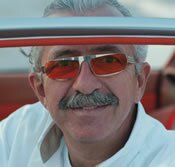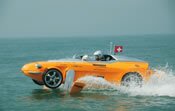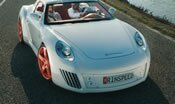Inflight Magazine of Brussels Airlines
Welcome to the Inflight Magazine of Brussels Airlines
The need for rinspeed
 James Bond’s gadget man Q presses a pedal and the car’s backlight glows with a luminous hologram. He flicks a switch and a series of sensors measure 007’s pulse. Another switch sees the roof fold away, transforming the four-seater into a pick-up truck.
James Bond’s gadget man Q presses a pedal and the car’s backlight glows with a luminous hologram. He flicks a switch and a series of sensors measure 007’s pulse. Another switch sees the roof fold away, transforming the four-seater into a pick-up truck.
Q presses one more control. A hydraulic system kicks in, and suddenly it’s an amphibious vehicle that hovers 60cm above the water. “That’s splashing,” says Bond. It’s not a vintage quip.
But nor is this pure fantasy. This kind of amazing gadgetry is the brainchild of a little-known Swiss company called Rinspeed, 28 years old this year. All the devices outlined above actually exist,
designed and developed by Rinspeed in conjunction with its hi-tech partners. Admittedly, they’re not all on one vehicle, but Rinspeed’s labs and workshops – an unexpected sight in a country that has little in the way of an automobile industry – have created concept vehicles that flip, stretch, swim and even respond to your state of mind.
“Creativity happens in the gut not in the head,” says Frank Rinderknecht, Rinspeed’s 50-year-old founder. “Your guts have ‘visions’ that can’t be justified rationally. That’s why each model is unlike any we’ve ever built before.”
 Rinspeed’s is one of the most eagerly anticipated unveilings at any motor show. It’s among the most influential, too. A few years ago, Rinspeed showed a model with a matt lacquer finish. At the last year’s Geneva Motor Show, some 25 companies did the same.
Rinspeed’s is one of the most eagerly anticipated unveilings at any motor show. It’s among the most influential, too. A few years ago, Rinspeed showed a model with a matt lacquer finish. At the last year’s Geneva Motor Show, some 25 companies did the same.
The company has always gone its own way. “You can learn from other
entrepreneurs, but you can never duplicate them,” says Rinderknecht. “Even if someone tells you not to do something, you still have to find out for yourself. For most of the years we’ve been in business, people have been sceptical. Only recently has the industry begun to take our ideas seriously, because every model is more advanced and we now have continuity.“Every project gives me grey hairs,” he adds. “With the Splash [pictured above], there were many times when I was close to tears. It was the sum of decades of stress, technology and Murphy’s law. Murphy is always around and sometimes he has a very big family.”
Bad luck laws aside, Rinderknecht has had a seemingly blessed career. In 1977, he launched a business converting cars for handicapped drivers, creating Rinspeed in 1979 with a move to more esoteric projects: the Aliporta, a VW Golf with gull-wing doors; the R69, »
FR » Besoin de Rinspeed
Q, l’homme aux gadgets de James Bond appuie sur la pédale et soudain, ce qui était une voiture de sport se transforme en véhicule amphibie, qui peut décoller à 60cm au-dessus de la surface de l’eau. “C’est décoiffant,” s’exclame Bond. Ce n’est pas un équipement d’origine.
 Mais ce n’est pas de la pure fantaisie non plus. Ce genre de gadget pour le secteur automobile est le terrain d’inspiration de Rinspeed, la société basée en Suisse fondée par Frank Rinderknecht en 1979. Sa première création était l’Aliporta, une VW Golf à qui il a donné des portes en forme d’ailes de mouettes. Vinrent ensuite la R69, une Porsche 911 croisée avec une Ferrari Testarossa et en 1997, son premier concept de voiture original, la Mono Ego à un seul siège. Depuis lors 13 modèles époustouflants ont suivi, parmi eux la Advantige Rone, la première voiture de sport à tourner au biofuel fabriqué à partir de déchets de cuisine et de jardin.
Mais ce n’est pas de la pure fantaisie non plus. Ce genre de gadget pour le secteur automobile est le terrain d’inspiration de Rinspeed, la société basée en Suisse fondée par Frank Rinderknecht en 1979. Sa première création était l’Aliporta, une VW Golf à qui il a donné des portes en forme d’ailes de mouettes. Vinrent ensuite la R69, une Porsche 911 croisée avec une Ferrari Testarossa et en 1997, son premier concept de voiture original, la Mono Ego à un seul siège. Depuis lors 13 modèles époustouflants ont suivi, parmi eux la Advantige Rone, la première voiture de sport à tourner au biofuel fabriqué à partir de déchets de cuisine et de jardin.
La société a toujours suivi son propre chemin, d’après Rinderknecht, “Nous opérons entre l’innovation et le commerce. Depuis peu seulement, l’industrie automobile a commencé à prendre nos idées au sérieux.”
Rinderknecht concède que certains véhicules sont plutôt des curiosités, mais d’autres recherches comme la Presto, qui se convertissent de petite voiture en salon familial, peuvent s’avérer très pratiques dans les villes actuelles surpeuplées. Le problème est que chaque design de Rinspeed – pièce unique, fait à la main, avec chaque élément développé à part entière – coûte aussi plus d’ €1million à fabriquer.
“Nous avons plein d’idées en attente d’être réalisées. Mais jusqu’à présent aucune d’entre elles n’ont pris leur envol, dit Rinderknecht. Il semble bien que sur ce point le monde cinématographique de James Bond devance le monde réel de Rinspeed. Mais seulement sur ce point.
a Porsche 911 crossbred with a Ferrari Testarossa; outlandish custom paint jobs; and, in 1997, its first original concept car, the Mono Ego single seater. Since then 13 outlandish models have followed, among them the Advantige Rone, the lowest sports car in the world and the first to be powered by biofuel made from kitchen and garden waste, and the Bedouin, the world’s fastest natural-gas powered car, made from a plastic composite (it’s also rustproof).
Each Rinspeed car is the product of countless problems solved. “All failure is a pain, but too many business people conclude that ‘it doesn’t work, so we won’t do it’. We operate between innovation and commerce. We need the money but want to do things people haven’t done before. This way we also have much more fun.”
Unfortunately, you’re unlikely to see Rinspeed vehicles on the road. Some, Rinderknecht concedes, are mere novelties. But others such as the Presto, which converts from a small car into a family saloon, might prove more practical. The problem is that each model – a one-off and hand-built, with every part developed from scratch – costs more than €1m to create. It’s largely because Rinspeed also operates a Porsche tuning and parts development business on the side that it’s able to fund its creative impulses.
 Rinderknecht has a word for these impulses: imagineering. “Most car companies are governed by engineers or accountants, so their results can be dull. Of course, car companies can never be as crazy as we are, but there’s a need to recognise that transport is about so much more than the need to get from A to B. If that was the case, Rolls-Royce wouldn’t exist. We’d all drive little Fiats. Only companies that understand this emotional element will succeed.”
Rinderknecht has a word for these impulses: imagineering. “Most car companies are governed by engineers or accountants, so their results can be dull. Of course, car companies can never be as crazy as we are, but there’s a need to recognise that transport is about so much more than the need to get from A to B. If that was the case, Rolls-Royce wouldn’t exist. We’d all drive little Fiats. Only companies that understand this emotional element will succeed.”
Rinderknecht is driven by the desire to polarise opinion. “You may think our designs are ugly, but you won’t forget them,” he says. “You have to provoke if you’re pushing the limits. Nobody needs a car that can drive over water, but it’s about making it possible regardless.”
Rinspeed’s next project remains tightly under wraps, but Rinderknecht says it’s “totally crazy”, as if any of the previous models have been entirely sane. Disappointingly, the one thing of which Rinderknecht is sure is that the 2007 model won’t fly.
“It isn’t possible to make a car that can fly,” says Rinderknecht. “We have plenty of ideas in the drawer waiting to be realised when technology advances, but so far none of them are going to fly.” That seems to be one way in which James
NL » Rinspeed doet het weer
James Bonds gadgetspecialist Q drukt een pedaal in, en wat ooit een sportauto was, wordt nu een amfibiewagen die 60 cm boven het water kan zweven. “That’s splashing”, reageert Bond, een wat flauwe woordspeling op “That’s smashing”.
Pure fictie? Niet helemaal! Rinspeed, een Zwitsers bedrijf dat in 1979 door Frank Rinderknecht werd opgericht, bedenkt dat soort autogadgets echt. Hun eerste creatie was de Aliporta, een VW Golf met vleugeldeuren. Dan volgde de R69, een Porsche 911 gekruist met een Ferrari Testarossa. En in 1997 was er de eerste originele conceptcar, de Mono Ego eenzitter. Ondertussen kregen we nog 13 excentrieke modellen, waaronder de Advantige Rone, de eerste sportwagen op biobrandstof van keuken- en tuinafval.
Het bedrijf heeft altijd een eigen koers gevaren. “We combineren het vernieuwende met het commerciële”, stelt Rinderknecht. “Het is nog maar sinds kort dat de automobielsector onze ideeën ernstig neemt.”
Rinderknecht geeft toe dat sommige van hun wagens gewoon technische snufjes zijn. Maar andere, zoals de Presto die men van een kleine auto in een gezinswagen kan ombouwen, zouden erg handig blijken in onze drukke steden. Enige probleem is het prijskaartje. De handgebouwde en originele Rinspeedontwerpen, met hun unieke onderdelen, kosten meer dan 1 miljoen euro.
“We hebben nog hopen ideeën klaarliggen”, vertelt Rinderknecht, “maar voorlopig zit een vliegende auto er niet in”. James Bond ligt dus voor op Rinspeed. Maar niet veel!
Leave a Reply
